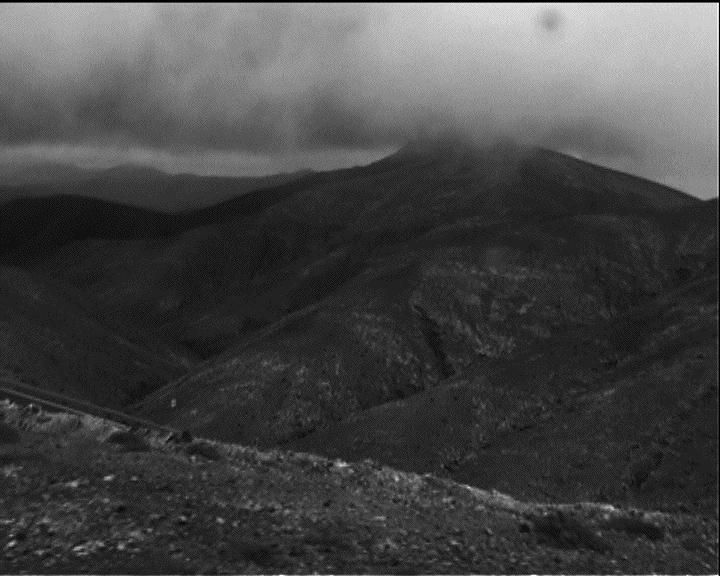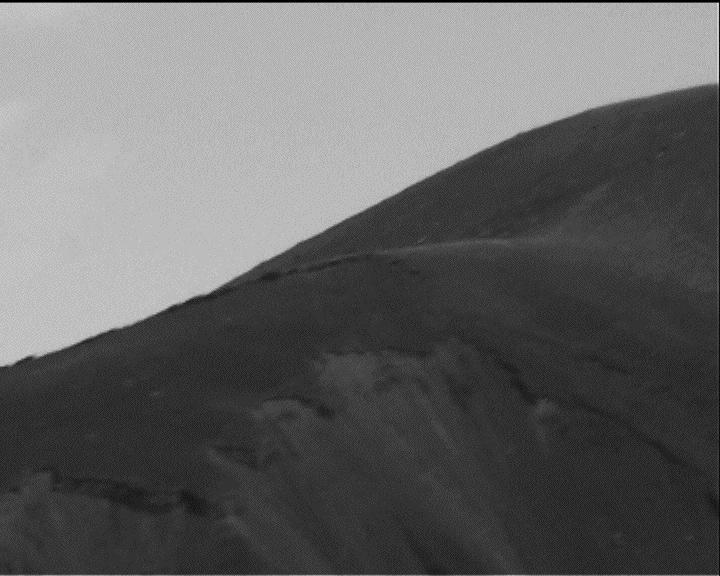around and around
Das Filmische hat sich immer im Spannungsfeld von Sichtbarkeit und ihrer Zerrüttung oder Auslöschung bewegt. In dem Maß, in dem die Bilder erscheinen und eine Ordnung der Sichtbarkeit herstellen, wird diese Ordnung gleichzeitig durch Schnitt und Montage, durch Anhalten oder Beschleunigen, durch Über- und Ausblenden an eine Grenze geführt, die sie zugleich konstituiert und gefährdet, zumindest aber in Frage stellt.
around and around von Annja Krautgasser bezieht sich auf diese Grenze in mehrfacher Hinsicht: Da ist zum einen der Horizont, zugleich Ende und unbekannter Anfang, die Teilung der Welt, die Grenzziehung des Blickfeldes; da ist aber auch der Rundblick, das Panorama, die Allsichtigkeit, das "skopische Regime der Moderne", die Überschreitung jeder Eingrenzung des Blicks, seine Entgrenzung; und da ist noch die Geschwindigkeit, die Beschleunigung, die Krise des Blicks wenn nicht gar sein katastrophales Scheitern. Und selbstverständlich ist da das Medium des Filmischen (nicht Video oder Film), das Annja Krautgasser in den Montagen vorbeihetzender Horizonte (markante Gebirge und geradezu abstrakte "Wüsten") - nicht thematisiert, auch nicht zeigt, aber vorführt, wie man sagen könnte. Gehört es zum Ereignis des Mediums, im Erscheinen sogleich wieder zu verlöschen, wie Jacques Derrida schreibt? Dann scheint sich around and around an jenem vagen "Saum" des Visuellen abzuarbeiten, an dem das filmische Bild zu verlöschen, hinter dem Horizont zu verschwinden droht, und scheint gegen diese Verlöschung mit ekstatischer Performanz (d. h. mit Mitteln des Filmischen) anzugehen. - Ein Hinauszögern des Verschwindens, das den "Raum" des Visuellen überhaupt erst zu ermöglichen scheint.
(Reinhard Braun)
around and around / française
À de nombreux égards, Around and Around dAnnja Krautgasser se réfère à cette zone-frontière, quil sagisse de lhorizon, aboutissement et point de départ inconnu tout à la fois, du partage du monde ou du tracé des frontières du champ visuel. Mais il y a aussi le tour dhorizon, le panorama, luniversalité, le « régime scopique de lépoque moderne », la transgression de toute limite imposée au regard et de sa mise hors limites. Et puis il y a encore la vitesse, laccélération et la crise du regard, voire même la désastreuse faillite de ce dernier. Et il y a bien sûr aussi le médium du travail filmique (et non de la vidéo ni du film), quAnnja Krautgasser se garde bien de thématiser ou de montrer, mais dont on pourrait dire quelle en fait la démonstration à travers ses montages où les horizons (montagnes saillantes ou « déserts » confinant à labstraction) défilent à une vitesse ahurissante. Apparaître pour disparaître aussitôt pourrait donc être, comme le dit Derrida, lessence même de lévénement médiatique? Around and Around semble alors sépuiser dans cette quête dun indéfinissable « ourlet » du visuel devant lequel limage filmique menace de se dissoudre, de disparaître derrière lhorizon, et semble combattre cette dissolution dans une performance extatique mettant en loccurrence en uvre les moyens filmiques. Une façon de retarder un processus de dissolution dont il semble quelle seule rendrait palpable l« espace » du visuel. (Reinhard Braun)
Traduction : Claude ManacŽh
Asymmetrical Focus (EN)
Text: David Komary
The exhibition Asymmetrical Focus continues to explore the topics of asymmetrical negotiations and considerations of space theory. Previous shows, Impermanent Geometry (2008) and Interfering Contours (2009), explored the constitution of spatiality in the context of the media; this show looks more precisely in the context of the motion picture film based image. While Miriam Bajtala and Annja Krautgasser focus on the specifics of the filmic and performative, their resulting media construction cannot be reduced to a technical/mechanical level. The artists investigate the basic constituents of the cinematographic aesthetics: movement and the interval. Questioning not only how cinematic images condense and synthesize, fragment and dissociate space and time, but also examining a dimension of the spatial, as inferred from the temporal fragmentation (Bajtala) and the acceleration of the film image (Krautgasser). It is the interval between images, the break in the pictorial-temporal representation, which generates a mimetic space. This space of media folds and breaks and does not revert to a space before or behind the camera, nor is it a space that could be derived from the kinaesthesia. Although a phenomenological component always plays a determining role in the spatial diegesis – the position of the viewer and his or her relationship to the work in the room – it is here above all that the phenomena of fleeting space, which brings together the medias inherent indeterminacy with the tension in the space between physical/actual and diegetic/imaginary space.
The artists in their analysis of cinematic imagery destabilize any form of geometric and optical focusing. The focal point of the image, as well as the camera position, seems off centre and uncertain. While Bajtala modulates the camera position in a film-diegetic and dynamic way, Krautgasser deprives the viewer, through the acceleration of the camera, of any certainty. Both artists infiltrate the telescopic gaze, the central perspective and the panoramic/panoptic gaze that reveals the subject as both the centre of perception and as the ideological centre of an authorial scheme of world production. The synthesis of a homogeneous space appears impossible; the viewer is confronted instead with the asymmetrical, decentred and destabilized phenomena of pictorial acceleration. Instead of coming from a non-centred state of affairs to a more centred one, the artists working, albeit in very different ways, with an aesthetic of camera-based acceleration to approach closer to a non-centred perception.1
The camera becomes a “centre of indeterminacy”.2 Both artists define/set the instrumental apparatus of the camera in relation to their own vision and body. The medium, the camera, hereby functions neither as an extension nor as prosthesis of the gaze. The film/video image as well as the camera portray – in the sense of a technological media that acts as interface of image, gaze, and subject – a specific ratio of image origin and use, which constitutes itself within a socio-cultural context. If the view has always been and still is mediatised, it is revealed by the gaze via the camera, so to speak filmic, as a media technology, which continuously assigns – media inscribed – a location to the subject, which articulates itself.
Annja Krautgasser’s Around and Around is – at least at first glance – a simply structured video. The artist records the surrounding area with the camera, the landscape of an island, following various points along the coastline. She rotates around her own axis, so the video appears as a moving image stream along the horizon. Krautgasser measures the limits of the coast in two ways, on the one hand physically, by pacing the shoreline to capture the boundary of the topographic area of the island, the other by means of a rotating movement of the camera to explore the limits of the apparatus: How far does the eye extend with the camera, where ends the visibility of this upgraded, telescopic gaze? Of the two different recording methods, Krautgasser creates a film, which seems to follow a panoptic logic. The result of this dynamic rotating form of account is not a calm, centred, or contemplative landscape; rather, it forms a visual current, a flow of images, based on the movement of the artist on her axis. This performative visual process, played out in a “natural” environment, leads to the permanent displacement at the centre of the image. With this centre being used to asymmetrically deterritorialise space, an opposite to the macroscopic gaze is reached, a loss of visibility. The clear, centred image and its related visual and historical view of the world which regards the subject as the centre of the works construction process, is dissolved. Instead, the landscape, the surrounding space is traced as a dynamic diagram of movement in search of a recording process or a knowing gaze.
The speed of rotation exceeds the threshold of perception, making it impossible to read the image. The landscapes are interchangeable, and appear as insignificant traces of accelerated perception. Krautgasser uses the medium as one of temporality, of an accelerated temporality deriving from the performative recording process. She shows no clear space, but refers to an area of action in which the cinematic is constituted between performance, the body’s action in space, posture, and perception. The body functions more as a centre of movement than as a centre of perception. In this narrowing and binding of the camera, view and body, she shows the media not as a prosthesis, which is able to aid the formation of an image, but as a transit hub. This “centre” is not that of a raised, central perspective or panoramic view regime, the subject is not a Cartesian-knowing, but one searching within the visual field.
Around and Around thus oscillates between the image and the visible, between defocusing and ephemerization. “Seeing” hereby reaches form “sighting” to the “visual”,3 making, the transition from the imaging unit to image stream. The cinematic image is formed on a permanent base and a permanent evocation of time image. It no longer underlies an order of time compared to movement; it leads toward a direct experience of time in terms of duration. The image, so to speak, is not setting a space, but tracing a time, highlighting a temporary nature of space. It is not only a medium of the temporal, because it modulates time, but because time is constituted in the period.
David Komary
------
1 See Gilles Deleuze, Cinema 1: The Movement-Image, Frankfurt a. M.: Suhrkamp 1989, p. 86.
2 Ibid., p. 92.
3 See Michael Wetzel, “The image and the visual”, in: Barbara Naumann, Edgar Pankow (ed.), “picture-thinking, Munich”: Fink 2004, p.174ff.
around and around
2007
Österreich
2 min



